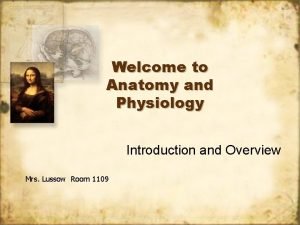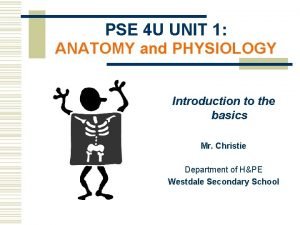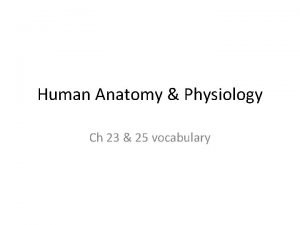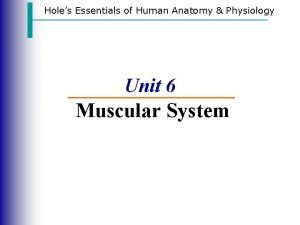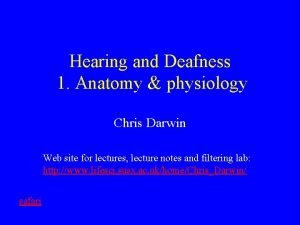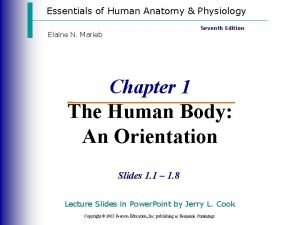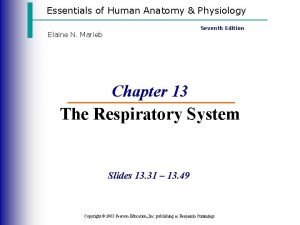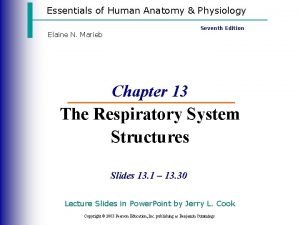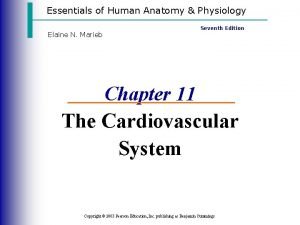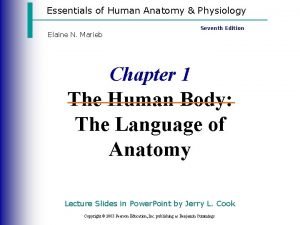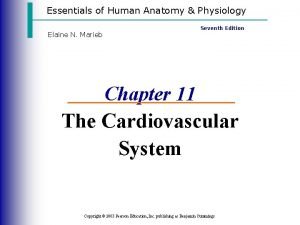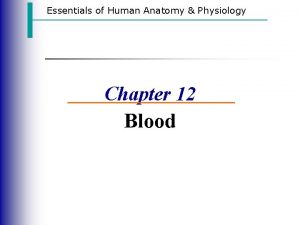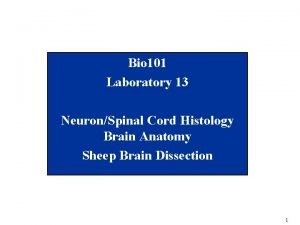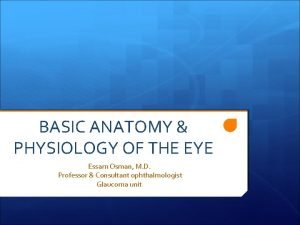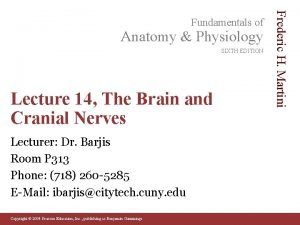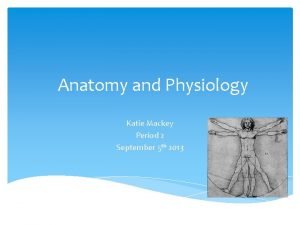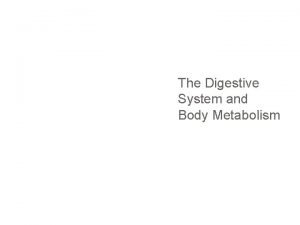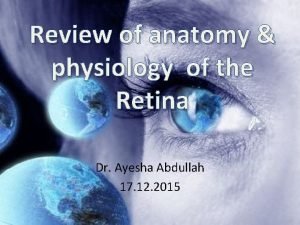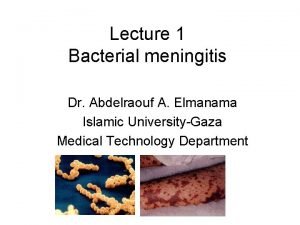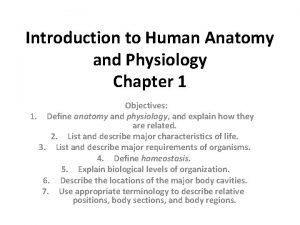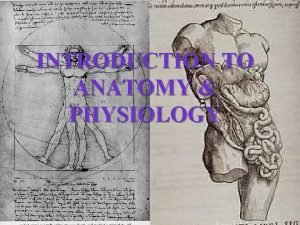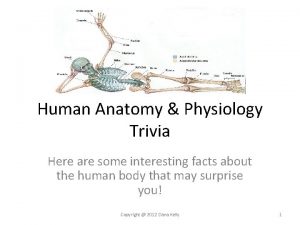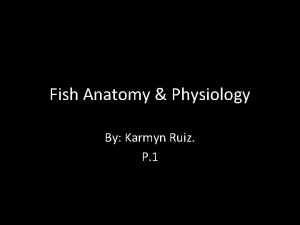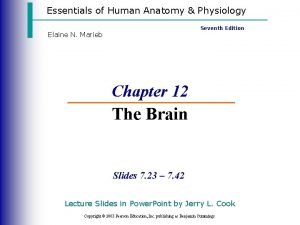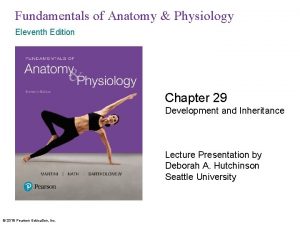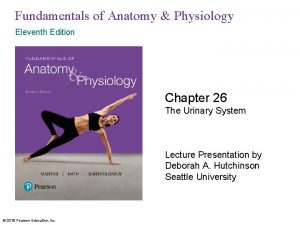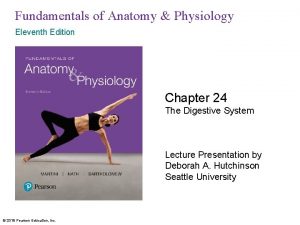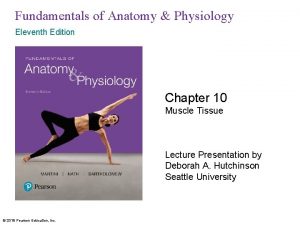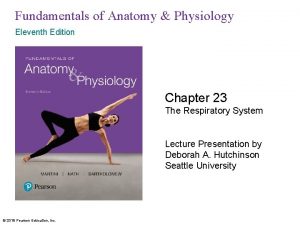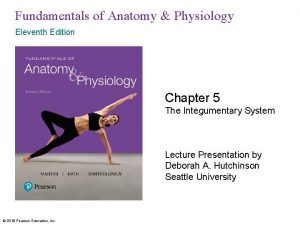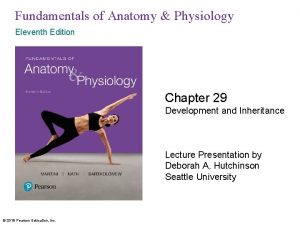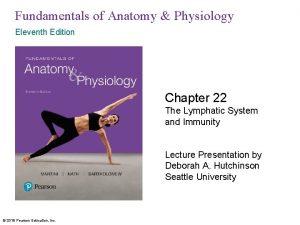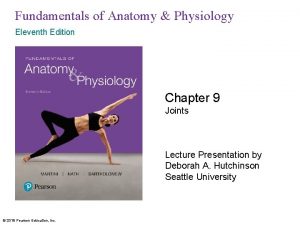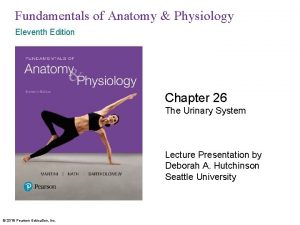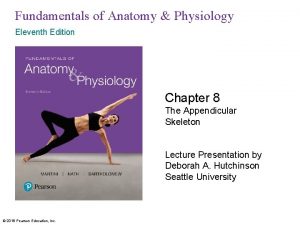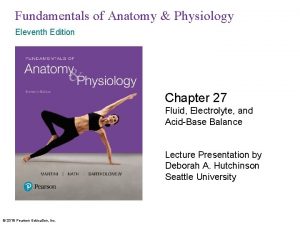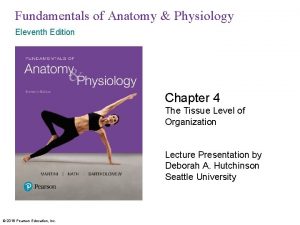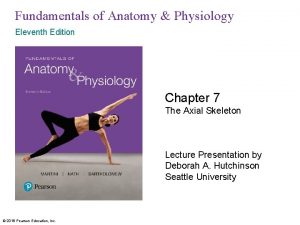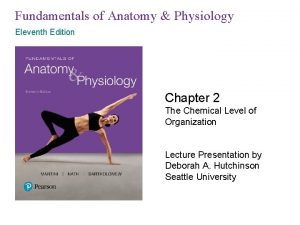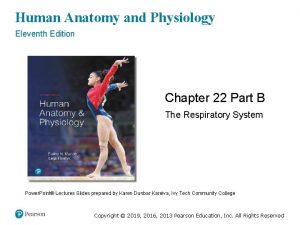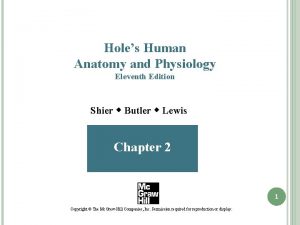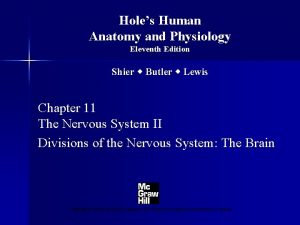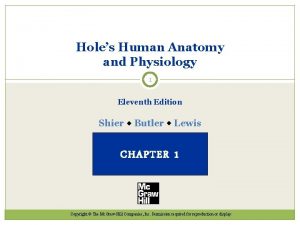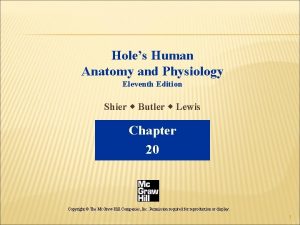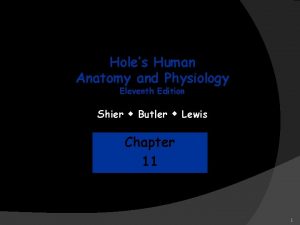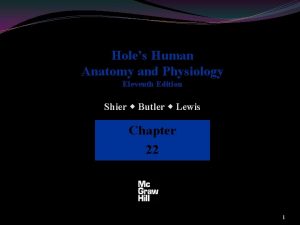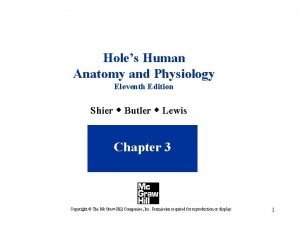Fundamentals of Anatomy Physiology Eleventh Edition Chapter 16




























































































- Slides: 92

Fundamentals of Anatomy & Physiology Eleventh Edition Chapter 16 The Autonomic Nervous System and Higher-Order Functions Lecture Presentation by Lori Garrett, Parkland College © 2018 Pearson Education, Inc.

Learning Outcomes 16 -1 Compare the organization of the autonomic nervous system with that of the somatic nervous system, and name the divisions and major functions of the ANS. 16 -2 Describe the structures and functions of the sympathetic division of the autonomic nervous system. 16 -3 Describe the types of neurotransmitters and receptors and explain their mechanisms of action. 16 -4 Describe the structures and functions of the parasympathetic division of the autonomic nervous system. 16 -5 Describe the mechanisms of parasympathetic neurotransmitter release and their effects on target organs and tissues. 2 © 2018 Pearson Education, Inc.

Learning Outcomes 16 -6 Compare and contrast the sympathetic and parasympathetic nervous systems. 16 -7 Discuss the functional significance of dual innervation and autonomic tone. 16 -8 Describe the hierarchy of interacting levels of control in the autonomic nervous system, including the significance of visceral reflexes. 16 -9 Explain how memories are created, stored, and recalled; distinguish among the levels of consciousness and unconsciousness; and describe how neurotransmitters influence brain function. 16 -10 Summarize the effects of aging on the nervous system and give examples of interactions between the nervous system and other organ systems. 3 © 2018 Pearson Education, Inc.

Introduction to ANS, Higher-Order Functions § Focus for this chapter – Autonomic nervous system (visceral motor system) • Operates without conscious instruction • Controls visceral effectors • Coordinates cardiovascular, respiratory, digestive, urinary, and reproductive functions – Higher-order functions • Consciousness • Learning • Intelligence 4 © 2018 Pearson Education, Inc.

16 -1 Autonomic Nervous System § Somatic nervous system (SNS) – Voluntary control of skeletal muscles § Autonomic nervous system (ANS) – Involuntary control of visceral effectors • Smooth muscle, glands, cardiac muscle, adipocytes – Hypothalamus contains integrative centers • Neurons comparable to upper motor neurons in SNS – Motor neurons of CNS synapse on visceral motor neurons in autonomic ganglia 5 © 2018 Pearson Education, Inc.

16 -1 Autonomic Nervous System § Visceral motor neurons – Preganglionic neurons in brainstem and spinal cord – Preganglionic fibers—axons of preganglionic neurons • After leaving CNS, they synapse on ganglionic neurons (postganglionic neurons) – Autonomic ganglia • Contain many ganglionic neurons that innervate visceral effectors • Postganglionic fibers—axons of ganglionic neurons 6 © 2018 Pearson Education, Inc.

Figure 16– 1 a Comparison of the Functional Organizations of the Somatic and Autonomic Nervous Systems. Upper motor neurons in primary motor cortex Brain Somatic motor nuclei of brainstem Skeletal muscle Lower motor neurons Skeletal muscle Spinal cord Somatic motor nuclei of spinal cord a Somatic nervous system 7

Figure 16– 1 b Comparison of the Functional Organizations of the Somatic and Autonomic Nervous Systems. Visceral motor nuclei in hypothalamus Brain Preganglionic neuron Visceral Effectors Smooth muscle Glands Cardiac muscle Autonomic ganglia Ganglionic neurons Adipocytes Preganglionic neuron Autonomic nuclei in brainstem Spinal cord Autonomic nuclei in spinal cord b Autonomic nervous system 8

16 -1 Autonomic Nervous System § Two divisions of ANS – Sympathetic division • “Fight or flight” • Prepares the body to deal with emergencies • Increases alertness, metabolic rate, and muscular abilities – Parasympathetic division • “Rest and digest” • Conserves energy and maintains resting metabolic rate 9 © 2018 Pearson Education, Inc.

16 -1 Autonomic Nervous System § Sympathetic and parasympathetic divisions – Usually have opposing effects • If sympathetic division causes excitation, the parasympathetic causes inhibition – May also work independently • Only one division innervates some structures – May work together, with each controlling one stage of a complex process 10 © 2018 Pearson Education, Inc.

16 -1 Autonomic Nervous System § Responses to increased sympathetic activity 1. Heightened mental alertness 2. Increased metabolic rate 3. Reduced digestive and urinary functions 4. Activation of energy reserves 5. Increased respiratory rate and dilation of respiratory passageways 6. Increased heart rate and blood pressure 7. Activation of sweat glands 11 © 2018 Pearson Education, Inc.

16 -1 Autonomic Nervous System § Responses to increased parasympathetic activity 1. Decreased metabolic rate 2. Decreased heart rate and blood pressure 3. Increased secretion by salivary and digestive glands 4. Increased motility and blood flow in digestive tract 5. Stimulation of urination and defecation 12 © 2018 Pearson Education, Inc.

16 -2 The Sympathetic Division § Sympathetic division (thoracolumbar division) – Short preganglionic fibers in thoracic and lumbar segments of spinal cord • Preganglionic neurons located between segments T 1 and L 2 • Cell bodies in lateral horns • Axons enter anterior roots – Ganglionic neurons in ganglia near spinal cord – Long postganglionic fibers to target organs 13 © 2018 Pearson Education, Inc.

Figure 16– 2 a The Autonomic Nervous System. a Sympathetic Division (Thoracolumbar Division) Eye Pons Salivary glands Medulla oblongata Sympathetic nerves Superior Cervical sympathetic ganglia Middle Heart Inferior Cardiac and pulmonary plexuses Greater splanchnic nerve Gray rami to spinal nerves Lung Celiac ganglion Superior mesenteric ganglion Liver and gallbladder Stomach Lesser splanchnic nerve Spleen Pancreas Large intestine Postganglionic fibers to spinal nerves (innervating skin, blood vessels, sweat glands, arrector pili muscles, adipose tissue) Lumbar splanchnic nerves Small intestine Inferior mesenteric ganglion Adrenal medulla Sacral splanchnic nerves Sympathetic chain ganglia Kidney Spinal cord KEY Preganglionic fibers Postganglionic fibers Uterus Ovary Penis Scrotum Urinary bladder 14

16 -2 The Sympathetic Division § Ganglionic neurons synapse in three locations – Sympathetic chain ganglia – Collateral ganglia – Adrenal medullae § Sympathetic chain ganglia – On both sides of vertebral column – Control effectors in • Body wall • Thoracic cavity • Head • Neck • Limbs 15 © 2018 Pearson Education, Inc.

Figure 16– 3 a Sites of Ganglia in Sympathetic Pathways. a Sympathetic Chain Ganglia Spinal nerve Preganglionic Autonomic ganglion of right sympathetic chain neuron Autonomic ganglion of left sympathetic chain Innervates visceral effectors by spinal nerves White ramus communicans Sympathetic nerve (postganglionic fibers) Innervates visceral organs in thoracic cavity by sympathetic nerves Note: Both innervation patterns occur on each side of the body. Ganglionic neuron Gray ramus communicans KEY Preganglionic neurons Ganglionic neurons 16

16 -2 The Sympathetic Division § Collateral ganglia – Anterior to vertebral bodies – Contain ganglionic neurons that innervate abdominopelvic tissues and viscera Collateral Ganglia b Lateral horn White ramus communicans Splanchnic nerve (preganglionic fibers) Postganglionic fibers Collateral ganglion Innervates visceral organs in abdominopelvic cavity 17 © 2018 Pearson Education, Inc.

16 -2 The Sympathetic Division § Adrenal medulla – Center of each adrenal gland – Modified sympathetic ganglion – Ganglionic neurons have very short axons – When stimulated, they release neurotransmitters into bloodstream (not at synapse) • Function as hormones to affect target cells throughout body 18 © 2018 Pearson Education, Inc.

Figure 16– 3 c Sites of Ganglia in Sympathetic Pathways. c Preganglionic fibers Endocrine cells (specialized ganglionic neurons) The Adrenal Medullae Adrenal medullae Secretes neurotransmitters into general circulation 19

16 -2 The Sympathetic Division § Fibers in sympathetic division – Preganglionic fibers • Relatively short • Ganglia located near spinal cord – Postganglionic fibers • Relatively long, except at adrenal medullae § Sympathetic chain ganglia – 3 cervical – 10– 12 thoracic – 4– 5 lumbar – 4– 5 sacral – 1 coccygeal ganglion 20 © 2018 Pearson Education, Inc.

16 -2 The Sympathetic Division § Summary of sympathetic chain ganglia – Cervical, inferior lumbar, and sacral chain ganglia receive preganglionic fibers from T 1–L 2 – Only thoracic and superior lumbar ganglia (T 1–L 2) receive preganglionic fibers from white rami – Every spinal nerve receives a gray ramus from a ganglion of the sympathetic chain 21 © 2018 Pearson Education, Inc.

Figure 16– 2 a The Autonomic Nervous System. a Sympathetic Division (Thoracolumbar Division) Eye Pons Salivary glands Medulla oblongata Sympathetic nerves Superior Cervical sympathetic ganglia Middle Heart Inferior Cardiac and pulmonary plexuses Greater splanchnic nerve Gray rami to spinal nerves Lung Celiac ganglion Superior mesenteric ganglion Liver and gallbladder Stomach Lesser splanchnic nerve Spleen Pancreas Large intestine Postganglionic fibers to spinal nerves (innervating skin, blood vessels, sweat glands, arrector pili muscles, adipose tissue) Lumbar splanchnic nerves Small intestine Inferior mesenteric ganglion Adrenal medulla Sacral splanchnic nerves Sympathetic chain ganglia Kidney Spinal cord KEY Preganglionic fibers Postganglionic fibers Uterus Ovary Penis Scrotum Urinary bladder 22

16 -2 The Sympathetic Division § Collateral ganglia – Originate as paired ganglia (left and right) • Typically unpaired in adults due to fusion – Preganglionic fibers • Pass through sympathetic chain without synapsing • Form splanchnic nerves • In posterior wall of abdominal cavity 23 © 2018 Pearson Education, Inc.

16 -2 The Sympathetic Division § Collateral ganglia – Postganglionic fibers • Leave collateral ganglia • Extend throughout abdominopelvic cavity • Innervate visceral tissues and organs • Function to – Reduce blood flow and energy use by organs not vital to short-term survival – Release stored energy 24 © 2018 Pearson Education, Inc.

16 -2 The Sympathetic Division § Collateral ganglia – Celiac ganglion • Pair of interconnected masses of gray matter located at base of celiac trunk • May form single mass or many interwoven masses • Postganglionic fibers innervate stomach, liver, gallbladder, pancreas, and spleen – Superior mesenteric ganglion • Near base of superior mesenteric artery • Postganglionic fibers innervate small intestine and proximal two-thirds of large intestine 25 © 2018 Pearson Education, Inc.

16 -2 The Sympathetic Division § Collateral ganglia – Inferior mesenteric ganglion • Near base of inferior mesenteric artery • Postganglionic fibers provide sympathetic innervation to – Kidneys – Urinary bladder – Terminal segments of large intestine – Sex organs 26 © 2018 Pearson Education, Inc.

16 -2 The Sympathetic Division § Adrenal medulla – Modified sympathetic ganglion at center of each adrenal gland – Innervated by preganglionic fibers that synapse on cells that secrete • Epinephrine (adrenaline) • Norepinephrine (noradrenaline) – Epinephrine makes up 75– 80 percent of secretory output 27 © 2018 Pearson Education, Inc.

16 -2 The Sympathetic Division § Adrenal medulla – Bloodstream carries neurotransmitters throughout body – Causes changes in metabolic activities of different cells • Including cells not innervated by sympathetic postganglionic fibers – Effects last much longer than those produced by direct sympathetic innervation • Hormones continue to diffuse out of bloodstream 28 © 2018 Pearson Education, Inc.

16 -2 The Sympathetic Division § The sympathetic division can change the activities of specific effectors – Sympathetic activation – Occurs during a crisis – The entire division responds – Controlled by sympathetic centers in hypothalamus – Affects peripheral tissues and CNS activity 29 © 2018 Pearson Education, Inc.

16 -2 The Sympathetic Division § Changes caused by sympathetic activation – Increased alertness – Feelings of energy and euphoria – Increased blood pressure, heart rate, breathing rate, and depth of respiration – Elevation in muscle tone – Mobilization of energy reserves 30 © 2018 Pearson Education, Inc.

16 -3 Sympathetic Effects § Stimulation of sympathetic preganglionic neurons – Releases acetylcholine (ACh) at synapses with ganglionic neurons – Effect is always excitatory § Ganglionic neurons – Release neurotransmitters at target organs – Telodendria form branching networks – Each swollen segment is a varicosity • Packed with neurotransmitter vesicles • Membrane receptors scattered across target cells 31 © 2018 Pearson Education, Inc.

Figure 16– 4 Sympathetic Varicosities. Preganglionic fiber (myelinated) Ganglionic neuron Ganglion Postganglionic fiber (unmyelinated) Varicosities Vesicles containing norepinephrine (NE) Mitochondrion Schwann cell cytoplasm 5 µm Smooth muscle cells Varicosities 32

16 -3 Sympathetic Effects § Most sympathetic ganglionic neurons – Release NE at varicosities – Called adrenergic neurons § Some ganglionic neurons release ACh – Called cholinergic neurons – Located in body wall, skin, brain, and skeletal muscles 33 © 2018 Pearson Education, Inc.

16 -3 Sympathetic Effects § Effects of sympathetic stimulation – Result primarily from interactions of NE and E with adrenergic membrane receptors • Alpha receptors • Beta receptors – NE stimulates alpha receptors to greater degree than it does beta receptors – E stimulates both classes of receptors – Both are G-protein-coupled receptors 34 © 2018 Pearson Education, Inc.

16 -3 Sympathetic Effects § Majority of sympathetic postganglionic fibers release NE (adrenergic) – A few release ACh (cholinergic) • Stimulate sweat glands and dilate blood vessels of skeletal muscles and brain – Others release nitric oxide (NO) • Nitroxidergic synapses • Neurons innervate smooth muscles in blood vessel walls (e. g. , in skeletal muscles and brain) • Produce vasodilation and increased blood flow 35 © 2018 Pearson Education, Inc.

16 -4 The Parasympathetic Division § Parasympathetic division (craniosacral division) – Long preganglionic fibers in brainstem and sacral segments of spinal cord • Autonomic nuclei are in all parts of brainstem and lateral horns of S 2–S 4 – Ganglionic neurons in peripheral ganglia within or adjacent to target organs – Short postganglionic fibers in or near target organs 36 © 2018 Pearson Education, Inc.

Figure 16– 2 b The Autonomic Nervous System. b Parasympathetic Division (Craniosacral Division) Pterygopalatine ganglion Oculomotor (III) Lacrimal gland Eye Ciliary ganglion Pons Facial (VII) Medulla oblongata Glossopharyngeal (IX) Salivary glands Submandibular ganglion Otic ganglion Vagus (X) Heart Lungs Autonomic plexuses (see Figure 16– 6 ) Liver and gallbladder Stomach Spleen Pancreas Large intestine Pelvic nerves Small intestine Rectum Spinal cord Kidney KEY Preganglionic fibers Postganglionic fibers Uterus Ovary Penis Scrotum Urinary bladder 37

16 -4 The Parasympathetic Division § Ganglionic neurons in peripheral ganglia – Terminal ganglion • Near target organ • Usually paired – Intramural ganglion • Embedded in tissues of target organ • Consists of interconnected masses and clusters of ganglion cells 38 © 2018 Pearson Education, Inc.

16 -4 The Parasympathetic Division § Organization of parasympathetic division – Parasympathetic preganglionic fibers leave brain in cranial nerves • III (oculomotor) • VII (facial) • IX (glossopharyngeal) • X (vagus) – Control visceral structures in head – Synapse in ciliary, pterygopalatine, submandibular, and otic ganglia 39 © 2018 Pearson Education, Inc.

16 -4 The Parasympathetic Division § Vagus nerve – Provides 75 percent of all parasympathetic outflow – Innervates structures in • Neck • Thoracic and abdominopelvic cavities including distal portion of large intestine – Branches intermingle with fibers of sympathetic division 40 © 2018 Pearson Education, Inc.

16 -4 The Parasympathetic Division § Preganglionic fibers in sacral segments of spinal cord – Carry sacral parasympathetic output – Do not join anterior roots of spinal nerves – Form pelvic nerves • Innervate intramural ganglia in kidneys, urinary bladder, portions of large intestine, and sex organs 41 © 2018 Pearson Education, Inc.

Figure 16– 2 b The Autonomic Nervous System. b Parasympathetic Division (Craniosacral Division) Pterygopalatine ganglion Oculomotor (III) Lacrimal gland Eye Ciliary ganglion Pons Facial (VII) Medulla oblongata Glossopharyngeal (IX) Salivary glands Submandibular ganglion Otic ganglion Vagus (X) Heart Lungs Autonomic plexuses (see Figure 16– 6 ) Liver and gallbladder Stomach Spleen Pancreas Large intestine Pelvic nerves Small intestine Rectum Spinal cord Kidney KEY Preganglionic fibers Postganglionic fibers Uterus Ovary Penis Scrotum Urinary bladder 42

16 -4 The Parasympathetic Division § Major effects of parasympathetic division – Constriction of pupils and focusing on near objects – Secretion by digestive glands – Absorption and use of nutrients by peripheral cells – Changes associated with sexual arousal – Increased smooth muscle activity in digestive tract – Stimulation and coordination of defecation – Contraction of urinary bladder during urination – Constriction of respiratory passageways – Reduction in heart rate and force of contraction 43 © 2018 Pearson Education, Inc.

16 -5 Parasympathetic Effects § All parasympathetic neurons release ACh – Effects on postsynaptic cell vary widely • Due to different types of receptors • Or nature of second messenger involved – Effects of parasympathetic stimulation of cholinergic receptors are localized and short lived • Most ACh is inactivated at synapse by acetylcholinesterase (ACh. E) • ACh that diffuses into surrounding tissues is inactivated by tissue cholinesterase 44 © 2018 Pearson Education, Inc.

16 -5 Parasympathetic Effects § Cholinergic receptors – Nicotinic receptors • On ganglion cells of sympathetic and parasympathetic divisions • Also occur at neuromuscular junctions of SNS • Exposure to ACh causes excitation of ganglionic neuron or muscle fiber 45 © 2018 Pearson Education, Inc.

16 -5 Parasympathetic Effects § Cholinergic receptors – Muscarinic receptors • At cholinergic neuromuscular or neuroglandular junctions in parasympathetic division • At cholinergic junctions in sympathetic division • G protein-coupled receptors • Effects are longer lasting than nicotinic receptors • Response is excitatory or inhibitory depending on activation or inactivation of specific enzymes 46 © 2018 Pearson Education, Inc.

16 -5 Parasympathetic Effects § Dangerous environmental toxins – Nicotine • Binds to nicotinic receptors • Targets autonomic ganglia and skeletal neuromuscular junctions • Nicotine poisoning may result in coma or death – Muscarine • Produced by some poisonous mushrooms • Binds to muscarinic receptors • Targets parasympathetic division 47 © 2018 Pearson Education, Inc.

16 -6 Summary of ANS Divisions § Sympathetic division has widespread effects – Two sets of sympathetic chain ganglia, three collateral ganglia, and two adrenal medullae – Short preganglionic fibers, long postganglionic fibers – Extensive divergence – Preganglionic neurons release ACh; most postganglionic fibers release NE – Effector response depends on second messengers 48 © 2018 Pearson Education, Inc.

16 -6 Summary of ANS Divisions § Parasympathetic division has specific effects – Visceral motor nuclei are associated with cranial nerves III, VII, IX, and with S 2–S 4 – Ganglionic neurons are located in ganglia within or next to target organs – Innervates regions serviced by cranial nerves and organs in thoracic and abdominopelvic cavities – One-fifth the divergence of sympathetic division – All neurons are cholinergic – Effects are generally brief and restricted 49 © 2018 Pearson Education, Inc.

Figure 16– 5 A Summary Comparison of the Sympathetic and Parasympathetic Divisions. Sympathetic CNS Parasympathetic Preganglionic neuron PNS Preganglionic fiber Sympathetic ganglion KEY Neurotransmitters Acetylcholine Norepinephrine or Epinephrine Ganglionic neurons Bloodstream Postganglionic fiber Parasympathetic ganglion TARGET 50

16 -7 Dual Innervation § Dual innervation – Most vital organs are innervated by both divisions of ANS – Two divisions commonly have opposing effects – Parasympathetic postganglionic fibers travel by cranial nerves to peripheral destinations – Sympathetic innervation reaches same structures • From superior cervical ganglia of sympathetic chain 51 © 2018 Pearson Education, Inc.

16 -7 Dual Innervation § Anatomy of dual innervation – Autonomic plexuses • Nerve networks in the thoracic and abdominopelvic cavities • Formed by mingled sympathetic postganglionic fibers and parasympathetic preganglionic fibers • Travel with blood and lymphatic vessels that supply visceral organs 52 © 2018 Pearson Education, Inc.

16 -7 Dual Innervation § Cardiac plexus and pulmonary plexus – Intersecting autonomic fibers in thoracic cavity – Contain • Sympathetic and parasympathetic fibers for heart and lungs, respectively • Parasympathetic ganglia that affect those organs § Esophageal plexus – Contains • Descending branches of vagus nerves • Splanchnic nerves leaving sympathetic chain – Parasympathetic preganglionic fibers of vagus nerve enter abdominopelvic cavity with esophagus – Fibers enter celiac plexus 53 © 2018 Pearson Education, Inc.

16 -7 Dual Innervation – Celiac plexus (solar plexus) • Associated with smaller plexuses, such as inferior mesenteric plexus • Innervates viscera within abdominal cavity § Hypogastric plexus – Innervates digestive, urinary, and reproductive organs of pelvic cavity – Contains • Parasympathetic outflow of pelvic nerves • Sympathetic postganglionic fibers from inferior mesenteric ganglion • Splanchnic nerves from sacral sympathetic chain 54 © 2018 Pearson Education, Inc.

Figure 16– 6 The Autonomic Plexuses and Ganglia. Aortic arch Right vagus nerve Autonomic Plexuses and Ganglia Cardiac plexus Trachea Left vagus nerve Thoracic spinal nerves Pulmonary plexus Thoracic sympathetic chain ganglia Esophageal plexus Esophagus Splanchnic nerves Celiac plexus and ganglion Superior mesenteric ganglion Inferior mesenteric plexus and ganglia Diaphragm Superior mesenteric artery Inferior mesenteric artery Hypogastric plexus Pelvic sympathetic chain 55

16 -7 Dual Innervation § The heart receives dual innervation – Acetylcholine released by parasympathetic postganglionic fibers slows heart rate – NE released by varicosities of sympathetic division accelerates heart rate • Small amounts of both are released continuously, producing autonomic tone – Parasympathetic division dominates at rest – Crisis speeds heart rate by stimulating sympathetic and inhibiting parasympathetic nerves 56 © 2018 Pearson Education, Inc.

16 -7 Dual Innervation § Some organs are innervated by only one division – Example: sympathetic control of blood vessel diameter – NE is released from sympathetic fibers at smooth muscle cells in blood vessel walls • Sympathetic tone keeps muscles partially contracted – When more blood flow is needed, • Rate of NE release decreases • Sympathetic cholinergic fibers are stimulated • Smooth muscle cells relax and blood vessel dilates 57 © 2018 Pearson Education, Inc.

16 -8 Regulation of Autonomic Functions § Centers involved in somatic motor control – Are found in all portions of CNS • Lower motor neurons of cranial and spinal reflex arcs • Pyramidal motor neurons of primary motor cortex – Simple reflexes based in spinal cord respond rapidly and automatically to stimuli – Centers in brainstem control activity of sympathetic and parasympathetic divisions 58 © 2018 Pearson Education, Inc.

16 -8 Regulation of Autonomic Functions § Visceral reflexes – Autonomic, polysynaptic reflexes initiated in viscera – Provide automatic motor responses – Can be modified, facilitated, or inhibited by higher centers, especially hypothalamus § Visceral reflex arc consists of – Receptor – Sensory neuron – Processing center (one or more interneurons) – Two visceral motor neurons 59 © 2018 Pearson Education, Inc.

16 -8 Regulation of Autonomic Functions § Visceral reflexes – Long reflexes • Autonomic equivalents of polysynaptic reflexes • Visceral sensory neurons deliver information to CNS along posterior roots of spinal nerves – Within sensory branches of cranial nerves – Within autonomic nerves that innervate visceral effectors • ANS carries motor commands to visceral effectors • Coordinate activities of entire organ • Most important in regulating visceral activities in most organs 60 © 2018 Pearson Education, Inc.

16 -8 Regulation of Autonomic Functions § Visceral reflexes – Short reflexes • Bypass CNS entirely • Involve sensory neurons and interneurons whose cell bodies lie in autonomic ganglia • Interneurons synapse on postganglionic neurons • Postganglionic fibers distribute motor commands • Control simple motor responses with localized effects – Control activity in one small part of target organ – Provide most control and coordination in digestive tract and associated glands • Neurons involved form enteric nervous system 61 © 2018 Pearson Education, Inc.

Figure 16– 7 Visceral Reflexes. Receptors in peripheral tissue Afferent (sensory) fibers CENTRAL NERVOUS SYSTEM Stimulus Short reflex Long reflex Processing center in spinal cord Response Peripheral effector Postganglionic neuron Autonomic ganglion Preganglionic (sympathetic or neuron parasympathetic) 62

16 -8 Regulation of Autonomic Functions § Enteric nervous system – Ganglia in walls of digestive tract contain cell bodies of • Visceral sensory neurons • Interneurons • Visceral motor neurons – Axons form extensive nerve nets – Capable of controlling digestive functions independent of CNS 63 © 2018 Pearson Education, Inc.

16 -8 Regulation of Autonomic Functions § Higher levels of autonomic control – Processing centers in medulla oblongata coordinate complex reflexes • Contains centers and nuclei involved in – – – Salivation Swallowing Digestive secretions Peristalsis Urinary function • Regulated by hypothalamus § Integration of ANS and SNS activities – Many parallels in organization and function – Integration occurs at brainstem – Both systems under control of higher centers © 2018 Pearson Education, Inc. 64

Figure 16– 8 A Comparison of Somatic and Autonomic Function. Central Nervous System Cerebral cortex Limbic system Thalamus Hypothalamus Somatosensory Visceral sensory Relay and processing centers in brainstem Somatic reflexes Lower motor Peripheral neuron Nervous System SNS Long reflexes Sensory pathways Preganglionic neuron ANS Short reflexes Ganglionic neuron Skeletal muscles Sensory receptors Visceral effectors 65

16 -9 Higher-Order Functions § Higher-order functions share three characteristics – Require the cerebral cortex – Involve conscious and unconscious information processing – Subject to adjustment over time • Not innate, fixed behaviors 66 © 2018 Pearson Education, Inc.

16 -9 Higher-Order Functions § Memories – Stored information gathered through experience – Fact memories • Specific bits of information – Skill memories • Learned motor behaviors • Incorporated at unconscious level with repetition • Brainstem stores those related to innate behaviors • Complex skill memories involve integration of motor patterns in basal nuclei, cerebral cortex, cerebellum 67 © 2018 Pearson Education, Inc.

16 -9 Higher-Order Functions § Short-term memories – Information can be recalled immediately – Do not last long – Contain small bits of information – Repeating information allows short-term memory to be converted to long-term memory • Memory consolidation § Long-term memories – Two types • Secondary memories – Fade with time and require effort to recall • Tertiary memories – Do not fade © 2018 Pearson Education, Inc. 68

Figure 16– 9 Memory Storage. Repetition promotes retention Sensory input Short-Term Memory Long-Term Memory Consolidation Secondary Memory Tertiary Memory • Cerebral cortex (fact memory) • Cerebral cortex and cerebellar cortex (skill memory) Temporary loss Permanent loss due to neural fatigue, shock, interference by other stimuli Permanent loss 69

16 -9 Higher-Order Functions § Brain regions involved in memory consolidation and access – Amygdaloid body and hippocampus – Nucleus basalis – Cerebral cortex § Amygdaloid body and hippocampus – Components of limbic system – Essential to memory consolidation – Damage to hippocampus causes • Inability to convert short-term memories to new long -term memories • Existing long-term memories remain intact and accessible 70 © 2018 Pearson Education, Inc.

16 -9 Higher-Order Functions § Nucleus basalis – Cerebral nucleus near diencephalon – Plays uncertain role in memory storage and retrieval – Tracts connect with hippocampus, amygdaloid body, and cerebral cortex – Damage changes emotional states, memory, and intellectual functions § Cerebral cortex – Stores most long-term memories – Conscious motor and sensory memories are referred to appropriate association areas – Portions of occipital and temporal lobes • Crucial to memories of faces, voices, and words • A specific neuron may be activated by only one word or by a specific combination of sensory stimuli © 2018 Pearson Education, Inc. 71

16 -9 Higher-Order Functions § Cellular mechanisms of memory formation and storage – Involves anatomical and physiological changes in neurons and synapses • Increased neurotransmitter release • Facilitation at synapses • Formation of additional synaptic connections § Increased neurotransmitter release – A frequently active synapse increases amount of neurotransmitter it stores – Releases more on each stimulation – The more neurotransmitter released, the greater the effect on postsynaptic neuron 72 © 2018 Pearson Education, Inc.

16 -9 Higher-Order Functions § Facilitation at synapses – A repeatedly activated neural circuit results in continuous release of neurotransmitters – Neurotransmitter binds to receptors on postsynaptic membrane – Produces graded depolarization that brings membrane closer to threshold – Resulting facilitation affects all neurons in circuit § Formation of additional synaptic connections – When neurons repeatedly communicate, – Axon tip branches and forms additional synapses on postsynaptic neuron – As a result, presynaptic neuron has greater effect on membrane potential of postsynaptic neuron © 2018 Pearson Education, Inc. 73

16 -9 Higher-Order Functions § Facilitated communication along a specific neural circuit – Caused by anatomical changes – Thought to be the basis of memory storage § Memory engram – Single circuit that corresponds to a single memory – Forms as result of experience and repetition – Takes at least an hour to form 74 © 2018 Pearson Education, Inc.

16 -9 Higher-Order Functions § Factors affecting formation of memory engrams – Nature, intensity, and frequency of original stimulus – Drugs that stimulate CNS (caffeine, nicotine) may enhance memory consolidation – Hippocampus, through unknown mechanism • Linked to NMDA (N-methyl D-aspartate) receptors • Blocking these receptors prevents long-term memory formation 75 © 2018 Pearson Education, Inc.

16 -9 Higher-Order Functions § States of consciousness – Many degrees of conscious and unconscious states – Degree of wakefulness indicates level of ongoing CNS activity – When CNS function is abnormal or depressed, state of wakefulness is affected § Deep sleep – Also called slow-wave or non-REM (NREM) sleep – Entire body relaxes – Cerebral cortex activity is at minimum – Heart rate, blood pressure, respiratory rate, and energy use decline up to 30 percent 76 © 2018 Pearson Education, Inc.

16 -9 Higher-Order Functions § Rapid eye movement (REM) sleep – Active dreaming occurs – Changes in blood pressure and respiratory rate – EEG resembles awake state – Less receptive to outside stimuli than in deep sleep – Muscle tone decreases markedly – Intense inhibition of somatic motor neurons – Eyes move rapidly 77 © 2018 Pearson Education, Inc.

16 -9 Higher-Order Functions § Sleep – Alternate between REM and deep sleep – REM periods initially average 5 minutes • Increase to 20 minutes during 8 -hour period – Produces minor changes in physiological activities of organs and systems – Protein synthesis in neurons increases – Extended periods without sleep lead to disturbances in mental function 78 © 2018 Pearson Education, Inc.

Figure 16– 10 a States of Sleep. Awake REM sleep Deep (slow wave) sleep a An EEG of the various sleep states. The EEG pattern during REM sleep resembles the alpha waves typical of awake adults. 79

Figure 16– 10 b States of Sleep. Awake REM sleep Transition period Deep sleep 10: 00 P. M. Midnight 2: 00 A. M. 4: 00 A. M. 6: 00 A. M. Time b Typical pattern of sleep stages in a healthy young adult during a single night’s sleep. 80

16 -9 Higher-Order Functions § Arousal – Awakening from sleep – Function of the reticular formation • Extensive interconnections with sensory, motor, and integrative nuclei • And with pathways along brainstem – Determined by complex interactions between reticular formation and cerebral cortex 81 © 2018 Pearson Education, Inc.

16 -9 Higher-Order Functions § Reticular activating system (RAS) – Important brainstem component – Diffuse network in reticular formation – Extends from medulla oblongata to midbrain – Output of RAS projects to thalamic nuclei that influence large areas of cerebral cortex – When RAS is inactive, so is cerebral cortex – Stimulation of RAS produces widespread activation of cerebral cortex 82 © 2018 Pearson Education, Inc.

16 -9 Higher-Order Functions § Sleep is ended by any stimulus that activates reticular formation and RAS – Arousal occurs rapidly – Effects of a single stimulation of RAS last less than a minute – After that, consciousness is maintained by positive feedback from cerebral cortex, basal nuclei, etc. 83 © 2018 Pearson Education, Inc.

16 -9 Higher-Order Functions § Regulation of sleep–wake cycles – Involves interplay between nuclei that use different neurotransmitters – One group stimulates RAS with NE • Maintains awake, alert state – Another group depresses RAS with serotonin • Promotes deep sleep – “Dueling” nuclei located in brainstem 84 © 2018 Pearson Education, Inc.

Figure 16– 11 The Reticular Activating System (RAS). RAS CN Special sensory input II III V N C Reticular formation General cranial or spinal nerve input 85

16 -9 Higher-Order Functions § Brain chemistry – Changes in levels of neurotransmitters can strongly affect brain function and behavior § Example: Huntington’s disease – Destruction of ACh-secreting and GABA-secreting neurons in basal nuclei – Symptoms appear as basal nuclei and frontal lobes degenerate – Difficulty controlling movements – Intellectual abilities gradually decline 86 © 2018 Pearson Education, Inc.

16 -9 Higher-Order Functions § Serotonin – Affects sensory interpretation and emotional states – Compounds that enhance effects also produce hallucinations • Example: lysergic acid diethylamide (LSD) – Compounds that inhibit production or block action cause severe depression and anxiety – Fluoxetine (Prozac) slows removal of serotonin at synapses • One type of selective serotonin reuptake inhibitor 87 © 2018 Pearson Education, Inc.

16 -9 Higher-Order Functions § Dopamine – Inadequate levels cause motor problems of Parkinson’s disease – Excessive production may be associated with schizophrenia – Amphetamines (“speed”) stimulate secretion – Important in nuclei that control intentional movements 88 © 2018 Pearson Education, Inc.

16 -10 Effects of Aging on Nervous System § Effects of aging – Anatomical and physiological changes begin by age 30 • Accumulate over time – 85 percent of people over age 65 have changes in mental performance and CNS function § Common age-related anatomical changes – Reduction in brain size and weight • Decrease in volume of cerebral cortex • Elderly people have narrower gyri, wider sulci, and larger subarachnoid space – Reduction in number of neurons • Brain shrinkage linked to loss of cortical neurons • No neuronal loss in brainstem nuclei © 2018 Pearson Education, Inc. 89

16 -10 Effects of Aging on Nervous System § Common age-related anatomical changes – Decrease in blood flow to brain • Fatty deposits build up in walls of blood vessels • Reduces blood flow through arteries (arteriosclerosis) • Increases chances of cerebrovascular accident (CVA), or stroke – Changes in synaptic organization of brain • Synaptic connections are lost • Rate of neurotransmitter production declines 90 © 2018 Pearson Education, Inc.

16 -10 Effects of Aging on Nervous System § Anatomical changes lead to functional changes – Memory consolidation becomes more difficult – Secondary memories become harder to access – Hearing, balance, vision, smell, and taste become less acute – Reaction times are slowed – Reflexes weaken or disappear – Precision of motor control decreases – Motor patterns take longer to perform 91 © 2018 Pearson Education, Inc.

16 -10 Effects of Aging on Nervous System § Age-related changes in CNS do not interfere with ability to function in 85 percent of elderly people § Some individuals develop senile dementia (senility) § Memory loss § Anterograde amnesia § Emotional disturbances – Alzheimer’s disease is most common 92 © 2018 Pearson Education, Inc.
 Management eleventh edition
Management eleventh edition Management eleventh edition
Management eleventh edition Management eleventh edition
Management eleventh edition Management eleventh edition
Management eleventh edition Human anatomy and physiology seventh edition marieb
Human anatomy and physiology seventh edition marieb Anatomy and physiology edition 9
Anatomy and physiology edition 9 Human anatomy and physiology 10th edition
Human anatomy and physiology 10th edition Chapter 14 anatomy and physiology
Chapter 14 anatomy and physiology Chapter 1 introduction to human anatomy and physiology
Chapter 1 introduction to human anatomy and physiology Anatomy and physiology chapter 8 special senses
Anatomy and physiology chapter 8 special senses Chapter 13 anatomy and physiology of pregnancy
Chapter 13 anatomy and physiology of pregnancy Chapter 2 basic chemistry anatomy and physiology
Chapter 2 basic chemistry anatomy and physiology Heat and cold
Heat and cold Art labeling activity: figure 14.1 (3 of 3)
Art labeling activity: figure 14.1 (3 of 3) Chapter 10 blood anatomy and physiology
Chapter 10 blood anatomy and physiology Anatomy and physiology chapter 15
Anatomy and physiology chapter 15 Necessary life functions anatomy and physiology
Necessary life functions anatomy and physiology Holes anatomy and physiology chapter 1
Holes anatomy and physiology chapter 1 Anatomy and physiology chapter 15
Anatomy and physiology chapter 15 Chapter 1 introduction to human anatomy and physiology
Chapter 1 introduction to human anatomy and physiology Chapter 2 human reproductive anatomy and physiology
Chapter 2 human reproductive anatomy and physiology Anatomy and physiology chapter 8 skeletal system
Anatomy and physiology chapter 8 skeletal system Chapter 6 general anatomy and physiology
Chapter 6 general anatomy and physiology Chapter 1 an introduction to anatomy and physiology
Chapter 1 an introduction to anatomy and physiology Bhore committee
Bhore committee Eleventh 5 year plan
Eleventh 5 year plan Thfive
Thfive For his eleventh birthday elvis presley
For his eleventh birthday elvis presley Physiology of sport and exercise 5th edition
Physiology of sport and exercise 5th edition The upper respiratory tract
The upper respiratory tract Tattoo anatomy and physiology
Tattoo anatomy and physiology Science olympiad anatomy and physiology
Science olympiad anatomy and physiology Crown plants examples
Crown plants examples Bone metabolism
Bone metabolism Anatomy and physiology of gastritis
Anatomy and physiology of gastritis Liver hilus
Liver hilus Epigastric region
Epigastric region Epigastric region
Epigastric region Google
Google Http://anatomy and physiology
Http://anatomy and physiology Appendix anatomy and physiology
Appendix anatomy and physiology Aohs foundations of anatomy and physiology 1
Aohs foundations of anatomy and physiology 1 Aohs foundations of anatomy and physiology 1
Aohs foundations of anatomy and physiology 1 Anatomical planes
Anatomical planes Unit 26 self evaluation answers
Unit 26 self evaluation answers Science olympiad anatomy and physiology 2020 cheat sheet
Science olympiad anatomy and physiology 2020 cheat sheet Physiology of stomach ppt
Physiology of stomach ppt Anatomy and physiology diabetes
Anatomy and physiology diabetes Aohs foundations of anatomy and physiology 1
Aohs foundations of anatomy and physiology 1 Aohs foundations of anatomy and physiology 1
Aohs foundations of anatomy and physiology 1 Anatomy and physiology
Anatomy and physiology Cornell notes for anatomy and physiology
Cornell notes for anatomy and physiology Holes essential of human anatomy and physiology
Holes essential of human anatomy and physiology Anatomy and physiology unit 7 cardiovascular system
Anatomy and physiology unit 7 cardiovascular system Anatomy and physiology
Anatomy and physiology The speed at which the body consumes energy
The speed at which the body consumes energy Aohs foundations of anatomy and physiology 1
Aohs foundations of anatomy and physiology 1 Anatomy and physiology exam 1
Anatomy and physiology exam 1 Welcome to anatomy and physiology
Welcome to anatomy and physiology Anatomy and physiology of the foot
Anatomy and physiology of the foot Integumentary system psoriasis
Integumentary system psoriasis Physiology vs anatomy
Physiology vs anatomy Pancreas histology slide
Pancreas histology slide Anatomy and physiology vocabulary
Anatomy and physiology vocabulary Anatomy and physiology
Anatomy and physiology Anatomy and physiology
Anatomy and physiology Anatomy and physiology
Anatomy and physiology Body landmarks diagram
Body landmarks diagram Anatomy and physiology
Anatomy and physiology Anatomy and physiology
Anatomy and physiology Anatomy and physiology
Anatomy and physiology Anatomy and physiology
Anatomy and physiology Anatomy and physiology
Anatomy and physiology Anatomy and physiology
Anatomy and physiology Anatomy and physiology
Anatomy and physiology Figure 10-1 blood
Figure 10-1 blood Dorsal root ganglion labeled
Dorsal root ganglion labeled Anatomy and physiology of the eye
Anatomy and physiology of the eye Oblongata
Oblongata Irn.org anatomy and physiology
Irn.org anatomy and physiology Anatomy and physiology body parts
Anatomy and physiology body parts Unit 26 animal anatomy physiology and nutrition
Unit 26 animal anatomy physiology and nutrition Figure 14-2 digestive system
Figure 14-2 digestive system Anatomy and physiology of the retina
Anatomy and physiology of the retina Mucous connective tissue
Mucous connective tissue Anatomy and physiology of meningitis ppt
Anatomy and physiology of meningitis ppt Jeopardy anatomy and physiology game
Jeopardy anatomy and physiology game Definition of homeostasis
Definition of homeostasis Anatomy and physiology
Anatomy and physiology Respiratory system in man
Respiratory system in man Physiology trivia
Physiology trivia Superior mouth fish
Superior mouth fish Anatomy of brain
Anatomy of brain


























































